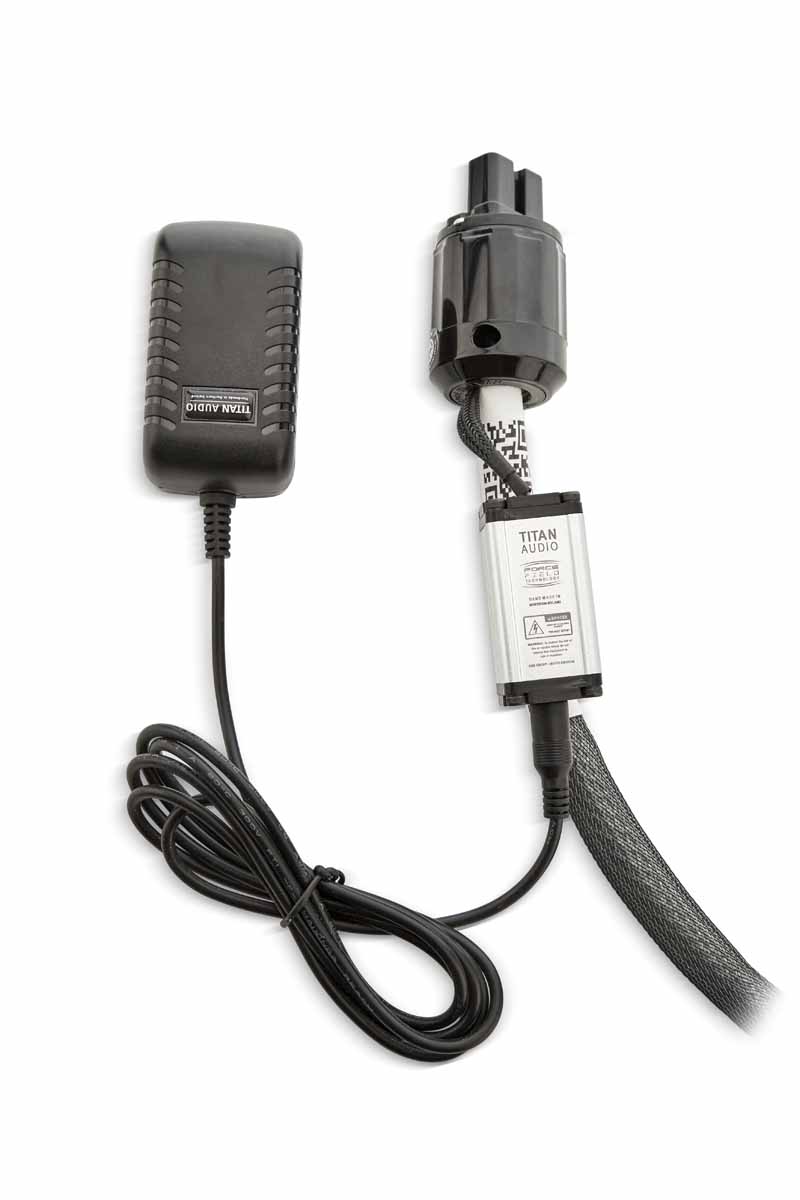Hifi Pig review of the Titan Audio’s Force Field Module that is designed to reduce the effects of RMI, EMI, and Wi-Fi interference in Audio systems.

Titan Audio Force Field Module
I have been using various levels of Titan Audio’s power cables and power blocks across my systems for the last 18 months or so and since then, and getting some in for review, I’ve been mightily impressed with the build quality, price points, and the sonic benefits of what is (to me) good, solid, and known engineering. It’s with this in mind that I say I am always keen to hear from them when their R&D folks have been in the lab and come up with something new – especially something a bit more…well… different. However, what I have been sent for consideration is not a cable, or a power block, or even a power conditioner. It is part of the power chain and seeks to address, in a new way, the one power cable issue I see even the cable sceptics agree on (perhaps) – interference. With the amount of “stuff” plugged in around our homes plus Wi-Fi and associated secondary booster hubs, the potential for interference, and increasingly airborne interference, is something we just can’t escape and this can have negative effects on our listening experience. With that in mind, and given how exciting the naming of this product is, I was more than happy (and very intrigued) to try Titans new ‘Force Field Technology Modules’.
CONSTRUCTION
Titan kit always arrives from their Northern Irish birthplace well packed, nicely presented, and there is a consistency of great quality materials. The Force Field Technology Module (FFT for short) comes in similar packaging to their cables and is a fairly unassuming brushed aluminium box that is not much bigger (but squarer) than a robust IEC plug. It has a small female connection port and a trailing cable to allow the module itself to be powered by its own “wall wart” type plug (however, Titan are soon to be launching a 5-in-1 power solution to power 5 modules from one source)
All new Titan power cables from their Helios level and up will now come with the connector wire to dock with the FFT module so the modules can be added as an upgrade at any time during the life of your cables. As I don’t have any of the new generation cables I was supplied with a new 3m Helios cable to pair with the module. These new cables still carry Titan’s usual smart design but also have an outer helix wire running end to end and a small umbilical that plugs into the FFT. A neat little velcro strap attaches the module “piggyback” style to the cable to reduce any weight on the connector cable. This combination of helix wire and module creates a protective field around the length of cable – in essence pushing the shielding out of the main core wiring and (instead) along its outer shell. This in turn means internal shielding can be more passive. As usual, the build quality feels very robust and well finished.
Titan’s boffins explained the approach aims to act as shielding and protection from Airborne RFI which should, in turn, lower noise floor and reduce distortion. The module also addresses another creeping issue that they see – that being as more layers of insulation and protection go into cabling there is a risk that dynamics suffer, a choking or smothering effect as I see it, especially on dynamics and top-end. This choking/smothering effect is certainly something many have reported with some low-cost power blocks. Therefore, when looking to tackle airborne effects, rather than adding more and more shielding, or internal windings the FFT module idea was born. These potentially deleterious effects are unquestionably increasing with the proliferation of wireless connections and Bluetooth, plus other devices around the home like microwaves and increasingly “smart” home technology in everything from light bulbs, thermostats etc. While I don’t subscribe to these signals making us ill (beyond some good studies around sleep impact) it’s clear to anyone we are swimming in a soup of RFI/EMI around the home these days and that can potentially play havoc with sensitive audio equipment. If, as one of my systems, your kit is very close to high RFI sources like Wifi routers, this can manifest more acutely.
SOUND QUALITY
For sonic evaluation, I took proceedings in two stages. Firstly I swapped out my existing Titan cabling on my Hegel 190 amp for the standard manufacturer-provided kettle lead so I was starting at the “no upgrade” baseline and ran in that mode for at least 2 weeks on and off before then introducing the new generation Helios cable into the mix and running in that mode for another week or so. Finally, I then introduced the FFT module into the chain. This was no quickie review and listening took place over almost 2 months! The musical fare was eclectic and sought to span different dimensions of music and dynamics – from the acoustic energy and detail of some Jazz greats through 80’s high production and complex layering of mainstream rock and onto the clean, bass-driven landscapes of electronica. One of my first go-to test tracks remains Simple Minds’New Gold Dream (81,82,83,84) – Abbey Road Half Speed Master edition. This record’s versions of “Someone Somewhere in Summertime” and “Colours Fly & Catherine Wheel” stand out as being stunningly produced and mastered. The bass and percussion separate beautifully when paired with the right equipment and the harmonies have a cleanliness to them that really shines when presented well.

Titan Audio Force Field Module in its packaging
As with a lot of reviews, these tracks paint differences in sound (or lack thereof) pretty much in black and white and straight out of the gate, and with the addition of Helios this was no exception. Running through my Vincent PHO 700 phonostage to the Hegel 190 there is an immediately obvious impact on bass – not that it’s suddenly deeper, rather it seems to be more defined and pulled forward and outwards in 3D space. There is also a marked “lifting” of all frequencies, with particular focusing of mids and highs that added an extra subtle punch to proceedings. As with most cables of a power variety, I didn’t expect and didn’t experience a “leap” in playback performance, but incrementally it was improved and delivery was certainly enhanced. With Donald Byrd’s Byrd in Flight (BN Tone Poet 2020 edition) the energy, emotion and agility of Byrd’s playing is reproduced wonderfully and as we move into the early sections of “Ghana” the effervescence of the band is just wonderful with Pearson’s fingers moving with a deftness, lightness, and pace of touch across the piano, unrestricted by any sonic muddying or smearing. Humphries’ cymbals were clear and airy and with an added energy but without loss of top-end sparkle.
With the Force Field Technology modules now in play, I returned to these favourites but also added in loved staples fed from the Aries G1 and Chord Qutest. Jean Michel Jarre’s Concerts in China was a favourite, with Arpeggiator stealing the show. Its fantastic bassline just made me fall in love with the tune all over again – that synth’s energy and the air created around the whole piece was a joy. With John Carpenter’s Lost Themes III synth stabs and basslines were tight, energetic, and bright, but never harsh. Background noise was non-existent and the dynamic range was fully expressed.
On the H190, the Titan Helios vs standard cable was a very clear upgrade, however, the FFT Module didn’t make as marked a difference when running to the amp, but I felt there was a noticeable lift in dynamics and a lower bed to the music when playing the Aries G1 – I do often find digital source benefit most from power conditioning!
Moving the cable and module to my dining room setup and to my Hegel H90 and Graham Slee Gram Amp 2 phonostage the difference was more marked. This set up has the dubious honour (due to space constraints) of being parked inside a bookshelf cupboard very near, not only the Wifi router but also a nest of cables. Here the A/B with the FFT resulted in a clearly lower noise floor and increased punch to the musical presentation.
CONCLUSION
Great quality power cabling and technology when used in the right conditions are for me a sound investment and can offer incremental sonic improvements – it’s about the aggregation of marginal gains. Swapping between a.n.other power cable I use for comparisons, it’s clear that the Titan Helios with the Force Field Modules in place that detail is sharpened, the noise-floor is suppressed a soupçon more, and overall energy feels more forward – without even the slightest hint of negative impact on dynamics. I am drawn into recordings and my foot taps that bit more.
The combination of cable and FFT module is more distinct than adding the FFM in isolation, but there is a degree of improvement overall. For those seeking to polish any rough edges and gain what they can, particularly in electrically noisy and WiFi congested situations, the combination of Titan cabling and Force Field Modules is well worth consideration.
AT A GLANCE
Build Quality: While fairly simple in aesthetic design, the materials and build quality are up to Titan’s usual high standard. Adding acrylic “caps” to the ends to remove vibration makes a lot of sense. Easy to connect and the piggyback strap removes any worry of strain on the umbilical. I look forward to the 5-in-1 power supply.
Sound Quality: Is it a night and day change? Not in my system, but it is a change. As with most power enhancements, I find when matched with the right components that detail is made more crystal, and energy is pushed forward. There is zero interference in the background that I can detect.
Value for Money: The Force Field Technology modules are not cheap, but if you are challenged with RFI/EMI, or want to protect against the possibility of interference, it’s likely you are already investing in aftermarket power cables and will see a good potential return on investment with these modules. These seem to be based on solid technology and a lot of R&D has gone into their design. I’ve seen far less well-engineered components that have had limited scientific backing cost more! Oh…and I bought it!
Pros: High-quality materials and build. An innovative approach to protection and dynamics preservation. Tangible sonic changes.
Cons: Requires extra sockets – being addressed soon. Consider weight on components IEC connector. Price may deter some.
Price: Expected price point to be £250 per module
Alan McIntosh
Review Equipment: Main – SL1210Mk3D (Origin Live Zephyr Tonearm, Timestep HE V linear PSU, Townsend Seismic Sink), Sumiko Blue Point Evo, Vincent Pho700 phonostage, Auralic Aries G1 Streaming Transport via Chord Shawline Digital BNC/ Coax to Chord Qutest DAC, Chord Shawline cabling (for Speakers, Aries and DAC), WyWires Blue for Turntable/Phono stage, Hegel 190 Amplifier, Amphion Argon 3s loudspeakers on Solid Steel stands. Streaming from Qobuz. Room acoustically treated with GIK Acoustics.
Secondary system – Technics SL1210, Graham Slee Gram Amp 2 Phono, Auralic Aries Mini, Pioneer PD-S901 stable platter CD (transport via optical), Hegel 90, QA Acoustics 3020. Chord Shawline cabling, C-Stream ethernet streaming cable.













































































































































































































You must be logged in to leave a reply.